|
|
|
|
|
Oil On
Canvas, Real Flavor of Old Masters
|
|

|
ARTWORKS
INDEX
A B C D E F G H I J K L M N O P Q R S T U V W X Y Z |
ARTISTS
INDEX
A B C D E F G H I J K L M N O P Q R S T U V W X Y Z |
|
|
| | |
|
|
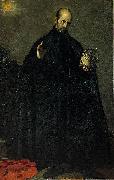 |
Alonso Cano -- Click Here
|
|
(19 March 1601 - 3 September 1667) was a Spanish painter, architect and sculptor born in Granada. He learned architecture from his father, Miguel Cano; painting in the academy of Juan del Castillo, and from Francisco Pacheco the teacher of Velezquez; and sculpture from Juan Martenez Montañ's. As a sculptor, his most famous works are the Madonna and Child in the church of Lebrija (also called Nebrija), and the colossal figures of San Pedro and San Pablo.
He was made first royal architect, painter to Philip IV, and instructor to the prince, Balthasar Charles, Prince of Asturias.The King gave him the church preferment of a canon of the Granada Cathedral (1652), in order to take up a position as chief architect of the cathedral, where his main achievement in architecture was the façade, designed at the end of his life and erected to his design after his death.
Ideal portrait of a Spanish King.He was notorious for his ungovernable temper; and it is said that once he risked his life by committing the then capital offence of dashing to pieces the statue of a saint, when in a rage with the purchaser who begrudged the price he demanded. According to another story, he found his house robbed after coming home one evening, his wife murdered, and his Italian servant fled. Notwithstanding the presumption against the fugitive, the magistrates condemned Cano, because he was of a jealous temper. Upon this he fled to Valencia, but afterwards returned to Madrid, where he was put to the torture, which he endured without incriminating himself, and the king received him into favour.
After the death of his wife he took Holy Orders as a protection from farther prosecution, but still continued his professional pursuits. He died in 1676. In his last moments, when the priest held to him a crucifix, he told him to take it away; according to the Catholic Encyclopedia, this was because the priest gave the Sacrament to conversos.
|
|
 |
ALLORI Cristofano -- Click Here
|
|
Italian Baroque Era Painter, 1577-1621
Allori was born at Florence and received his first lessons in painting from his father, Alessandro Allori, but becoming dissatisfied with the hard anatomical drawing and cold coloring of the latter, he entered the studio of Gregorio Pagani (1558-1605) who was one of the leaders of the late Florentine school, which sought to unite the rich coloring of the Venetians with the Florentine attention to drawing. Allori also appears to have worked under Cigoli.
His pictures are distinguished by their close adherence to nature and the delicacy and technical perfection of their execution. His technical skill is shown by the fact that several copies he made of Correggio's works were thought to be duplicates by Correggio himself. His extreme fastidiousness limited the number of his works. Several specimens are to be seen at Florence and elsewhere.
The finest of his works is his Judith with the Head of Holofernes. It exists in two copies in the Pitti Palace in Florence and in the Queen's Gallery in London. The model for the Judith was his mistress, the beautiful Mazzafirra, who is also represented in his Magdalene; and the head of Holofernes is generally supposed to represent himself. |
|
|
|
 |
Alfred Sacheverell Coke -- Click Here
|
|
fl.1869-1893
|
|
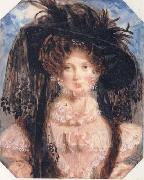 |
Alfred Eduard Chalon -- Click Here
|
|
British , (1780-1860) |
|
|
|
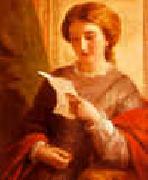 |
Alfred Chalon -- Click Here
|
|
English 1780-1860
Swiss-British painter and illustrator. Much of what we know about the look of romantic ballet is owed to his lithographs and illustrations. He was Taglioni portraitist and his 1845 lithograph of the Pas de quatre, with Carlotta Grisi, Marie Taglioni, Lucile Grahn, and Fanny Cerrito, is one of the most famous images in all dance. |
|
|
|
Alexandre-Francois Caminade -- Click Here
|
|
Alexandre-Francois Caminade (December 14, 1783 - May 1862) was a French painter.
Caminade was born and died in Paris. He was a portraitist and a religious painter. He was Jacques Louis David's pupil. See also, Larousse article at Cyclopedia of Painters and Paintings, eds. John Desnison Champlin and Charles Callahan Perkins |
|
|
|
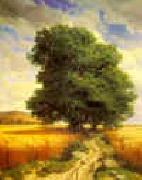 |
Alexandre Calame -- Click Here
|
|
1810-1864
French Alexandre Calame Locations
Swiss painter, draughtsman and printmaker. He studied under Francois Diday in Geneva and then travelled to Paris (1837), to the Netherlands and Desseldorf (1838), to Italy (1844) and to London (1850). Despite his frail health he spent each summer painting in the mountains of the Bernese Oberland and central Switzerland, where he produced the drawings and studies from nature that were later used in his studio compositions. A fervent Calvinist, he saw his subjects. |
|
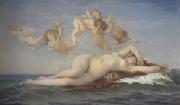 |
Alexandre Cabanel -- Click Here
|
|
French Academic Painter, 1823-1889
French painter and teacher. His skill in drawing was apparently evident by the age of 11. His father could not afford his training, but in 1839 his departement gave him a grant to go to Paris. This enabled him to register at the Ecole des Beaux-Arts the following October as a pupil of Franeois-Edouard Picot. At his first Salon in 1843 he presented Agony in the Garden (Valenciennes, Mus. B.-A.) and won second place in the Prix de Rome competition (after Leon B?nouville, also a pupil of Picot) in 1845 with Christ at the Praetorium (Paris, Ecole N. Sup. B.-A.). Both Cabanel and Benouville were able to go to Rome, as there was a vacancy from the previous year. Cabanel's Death of Moses (untraced), an academic composition, painted to comply with the regulations of the Ecole de Rome, was exhibited at the Salon of 1852. |
|
 |
Alexandre Cabanel -- Click Here
|
|
1823-1889
French Alexandre Cabanel Locations
French painter and teacher. His skill in drawing was apparently evident by the age of 11. His father could not afford his training, but in 1839 his departement gave him a grant to go to Paris. This enabled him to register at the Ecole des Beaux-Arts the following October as a pupil of Francois-Edouard Picot. At his first Salon in 1843 he presented Agony in the Garden (Valenciennes, Mus. B.-A.) and won second place in the Prix de Rome competition (after Lon Benouville, also a pupil of Picot) in 1845 with Christ at the Praetorium (Paris, Ecole N. Sup. B.-A.). Both Cabanel and Benouville were able to go to Rome, as there was a vacancy from the previous year. Cabanel Death of Moses (untraced), an academic composition, painted to comply with the regulations of the Ecole de Rome, was exhibited at the Salon of 1852. The pictures he painted for Alfred Bruyas, his chief patron at this time (and, like Cabanel, a native of Montpellier), showed more clearly the direction his art had taken during his stay in Italy. Albayde, Angel of the Evening, Chiarruccia and Velleda (all in Montpellier, Mus. Fabre) were the first of many mysterious or tragic heroines painted by Cabanel and show his taste for the elegiac types and suave finish of the Florentine Mannerists. |
|
|
|
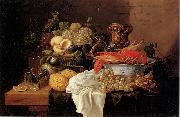 |
Alexander Coosemans -- Click Here
|
|
(1627, Antwerp - 1689, Antwerp), was a Flemish Baroque painter.
According to the RKD he was registered as a pupil of Jan Davidsz de Heem in 1641 and in 1645 he became a master in the Guild of St. Luke.He travelled to Rome in 1649 but was back in Antwerp in 1651. He painted flowers, fruit, and inanimate subjects, and flourished in the Netherlands about 1630. Fruit subjects by him are in the Augsburg Gallery and the Belvedere at Vienna. In the Madrid Gallery there is a fruit-piece attributed to a J. D. Cooseman, who is said to have flourished in the Netherlands in the 17th century: and in the Bordeaux Museum, a fruit-piece ascribed to a N. Coosman. He was followed by Hendrik Schoock. |
|
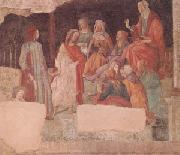 |
Alessandro Filipepe called botticelli -- Click Here
|
|
Florence ca 1445-1510 |
|
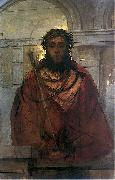 |
Albert Chmielowski -- Click Here
|
|
(born Adam Hilary Bernard Chmielowski; 1845 - 1916) was a Polish religious brother and founder of the Albertines. He is a saint of the Catholic Church. Albert is also known as Brat Albert (Brother Albert); in recognition of his holiness, he has also been called the "Brother of Our Lord", "Brother of Our God", and "Our God's Brother".
Adam Chmielowski was born to a wealthy aristocratic family, and initially studied agriculture with the intention of managing the family estate. Involved in politics since his youth, he lost a leg at the age of 17 while fighting in an insurrection. He became a well-known and well-liked artist in Krakew, his political convictions inspiring his interest in the human condition. A gentle and compassionate spirit, Chmielowski felt compelled to help those in need and after years of reflection, decided to follow his calling into the service of God.
In 1880, Chmielowski joined the Jesuits, took up the name Albert and abandoned painting. He began a life of service to the poor. In 1887, he founded the Brothers of the Third Order of Saint Francis, Servants of the Poor, known in honor of their founder as the Albertines or the Gray Brothers, after their rough gray habits. In 1891, he founded the women's congregation, the Gray Sisters. The Albertines organized food and shelter for the poor and homeless.
Albert believed that the great calamity of our time is that so many refuse to see and relieve the suffering of others. The so-called "haves" live away from the "have-nots", ignoring them and leaving their care to society.
|
|
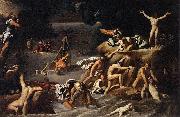 |
Agostino Carracci -- Click Here
|
|
(16 August 1557 ?C 22 March 1602) was an Italian painter and printmaker. He was the brother of the more famous Annibale and cousin of Lodovico Carracci.
He posited the ideal in nature, and was the founder of the competing school to the more gritty (for lack of a better term) view of nature as expressed by Caravaggio. He was one of the founders of the Accademia degli Incamminati along with his brother, Annibale Carracci, and cousin, Ludovico Carracci. The academy helped propel painters of the School of Bologna to prominence.
Agostino Carracci was born in Bologna, and trained at the workshop of the architect Domenico Tibaldi. Starting from 1574 he worked as a reproductive engraver, copying works of 16th century masters such as Federico Barocci, Tintoretto, Antonio Campi, Veronese and Correggio. He also produced some original prints, including two etchings.
He travelled to Venice (1582, 1587?C1589) and Parma (1586?C1587). Together with Annibale and Ludovico he worked in Bologna on the fresco cycles in Palazzo Fava (Histories of Jason and Medea, 1584) and Palazzo Magnani (Histories of Romulus, 1590?C1592). In 1592 he also painted the Communion of St. Jerome, now in the Pinacoteca di Bologna and considered his masterwork. From 1586 is his altarpiece of the Madonna with Child and Saints, in the National Gallery of Parma.
In 1598 Carracci joined his brother Annibale in Rome, to collaborate on the decoration of the Gallery in Palazzo Farnese. From 1598?C1600 is a triple Portrait, now in Naples, an example of genre painting.
In 1600 he was called to Parma by Duke Ranuccio I Farnese to began the decoration of the Palazzo del Giardino, but he died before it was finished.
Agostino's son Antonio Carracci was also a painter, and attempted to compete with his father's Academy.
|
|
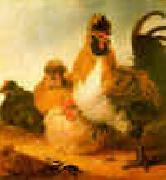 |
Aelbert Cuyp -- Click Here
|
|
1620-1691
Dutch
Aelbert Cuyp Locations
Painter and draughtsman, son of Jacob Cuyp. One of the most important landscape painters of 17th-century Netherlands, he combined a wide range of sources and influences, most notably in the application of lighting effects derived from Italianate painting to typical Dutch subjects. Such traditional themes as townscapes, winter scenes, cattle pieces and equestrian portraits were stylistically transformed and given new grandeur. Aelbert was virtually unknown outside his native town, and his influence in the 17th century was negligible. He became popular in the late 18th century, especially in England. |
|
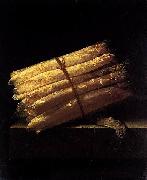 |
Adriaen Coorte -- Click Here
|
|
(ca. 1665 - after 1707) was a Dutch Golden Age painter of still lifes, who signed works between 1683 and 1707. He painted small and unpretentious still lifes in a style more typical of the first half of the century, and was "one of the last practitioners of this intimate category".
Very little is known of his life, but he is assumed to have been born and died in Middelburg. He became a pupil of Melchior d'Hondecoeter around 1680 in Amsterdam. From 1683 he seems to have returned to Middelburg, where he set up a workshop and signed his small, carefully balanced minimalist still lifes. He often painted on paper that was glued to a wooden panel. About 80 signed works by him have been catalogued, and nearly all of them follow the same pattern; small arrangements of fruits, vegetables, or shells on a stone slab, lit from above, with the dark background typical of still lifes earlier in the century. Instead of the Chinese or silver vessels favoured by his contemporaries, his tableware is very basic pottery. "Objects and light are studied intensely, and are painted with a wondrous tenderness".[1] Neither his birth nor death date is certain, and archival evidence only exists in Middelburg for his membership in the Guild of St. Luke there from 1695 onwards, when he was fined for selling a painting without being a member of the guild. His works appear frequently in contemporary Middelburg taxation inventories |
|
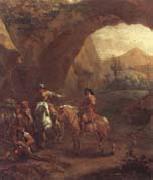 |
Adam Colonia -- Click Here
|
|
Dutch ,
Rotterdam 1634-1685 London
|
|
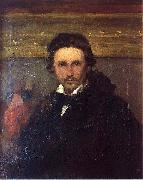 |
Adam Chmielowski -- Click Here
|
|
1845-1916) was a Polish religious brother and founder of the Albertines. He is a saint of the Catholic Church. Albert is also known as Brat Albert (Brother Albert); in recognition of his holiness he has also been called the "Brother of Our Lord", "Brother of Our God", and "Our God's Brother".
Adam Chmielowski was born to a wealthy aristocratic family, and initially studied agriculture with the intention of managing the family estate. Involved in politics since his youth, he lost a leg at the age of 17 while fighting in an insurrection. He became a well-known and well-liked artist in Krakew, his political convictions inspiring his interest in the human condition. A gentle and compassionate spirit, Chmielowski felt compelled to help those in need and after years of reflection, decided to follow his calling into the service of God.
In 1880, Chmielowski joined the Jesuits, took up the name Albert and abandoned painting. He began a life of service to the poor. In 1887, he founded the Brothers of the Third Order of Saint Francis, Servants of the Poor, known in honor of their founder as the Albertines or the Gray Brothers, after their rough gray habits. In 1891, he founded the women's congregation, the Gray Sisters. The Albertines organized food and shelter for the poor and homeless. |
|
 |
abstract composition -- Click Here
|
|
Russian painter, sculptor, designer and photographer. He was a central exponent of Russian Constructivism, owing much to the pre-Revolutionary work of Malevich and Tatlin, and he was closely involved in the cultural debates and experiments that followed the Revolution of 1917. In 1921 he denounced, on ideological grounds, easel painting and fine art, and he became an exponent of Productivism (see CONSTRUCTIVISM,
|
|
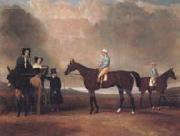 |
Abraham Cooper -- Click Here
|
|
British Painter, 1787-1868
English animal and battle painter, the son of a tobacconist, was born in London. At the age of thirteen he became an employee at Astley's Amphitheatre, and was afterwards groomed in the service of Sir Henry Meux. When he was twenty-two, wishing to possess a portrait of a favorite horse under his care, he bought a manual of painting, learned something of the use of oil-colours, and painted the picture on a canvas hung against the stable wall. His master bought it and encouraged him to continue in his efforts. He accordingly began to copy prints of horses, and was introduced to Benjamin Marshall, the animal painter, who took him into his studio, and seems to have introduced him to the Sporting Magazine, an illustrated periodical to which he was himself a contributor. In 1814 he exhibited his Tam O'Shanter, and in 1816 he won a prize for his Battle of Ligny. In 1817 he exhibited his Battle of Marston Moor and was made associate of the Academy, and in 1820 he was elected Academician. Cooper, although ill-educated, was a clever and conscientious artist; his coloring was somewhat flat and dead, but he was a master of equine portraiture and anatomy, and had some antiquarian knowledge. |
|
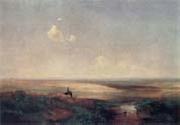 |
A.K.Cabpacob -- Click Here
|
|
1830-1897
Russia Artist |
|
|
|
|
| | |
|
|
|
|